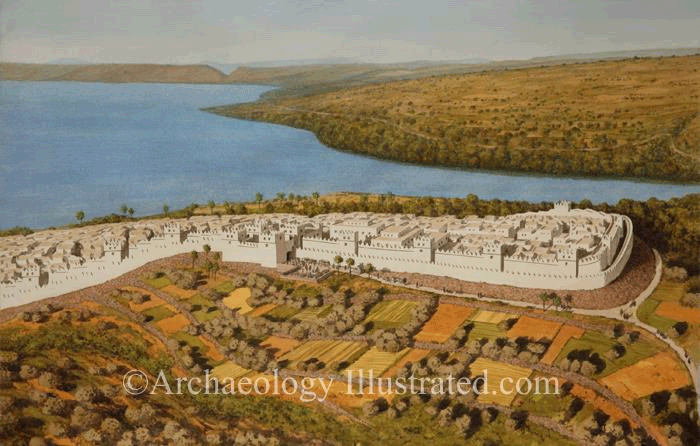Our Mission
Our mission is to excavate the ancient city of Bethsaida, research the remains and finds, and disseminate the results to both academic and popular audiences.

Historic Importance
The site, situated on e-Tell and identified with Bethsaida, was founded in the 10th century BCE on a basalt hill extending from the Golan plateau. The size of the city (20 acres), its majestic fortifications, its enormous gate - the largest ever found in southern Levant - and a palace indicates that this site served as the capital of the elusive biblical kingdom of Geshur. The kingdom was destroyed by the Assyrian King Tiglath Pileser III in 732 BCE.
The conquest of Alexander the Great in 333 BCE created a new "globalization" era with economic opportunities that resulted in an impressive return of prosperity to the entire region. As part of this rising prosperity, Bethsaida was resettled as a Phoenician colony. This colony thrived. However, the conquest of the Hasmoneans in about 100 BCE put an end to this prosperity and the majority of the inhabitants abandoned the place. This drop in population lasted until the time of Herod the Great when the responsibility for security of the region was given to Herod.
Herod settled Galilee and the Golan with Jews sent from Judea, as indicated by Herodian coins, oil lamps, and limestone vessels found at Bethsaida. This population, smaller in size than the earlier Phoenician population, constructed new homes on the summit of the site and occupied and renovated the old deserted Phoenician houses. As the name Bethsaida (The House of the Fishermen) implies, their main business was fishing. Hundreds of fishing implements were discovered at Bethsaida; they include lead and stone net weights, fishing hooks, anchors, and line sinkers.
This is the village into which the disciples of Jesus, Peter, Andrew, and Philip and perhaps the Zebedee brothers were born and raised. This is the place that was visited by Jesus and witnessed his mighty works. And against this backdrop, it is clear to understand the call of Jesus for his disciples to become fisherman of men.
In the year 30 CE, Philip, the son of Herod the Great, elevated the village to a status of a polis and, in an attempt to take part in the Roman imperial cult, he renamed it Julias. Philip re-populated and reinforced the city, and he dedicated a small shrine in honor of Julia/Livia. Remains of this reinforcement were discovered in the excavations.
When Bethsaida was first built in the 10th century BCE, the Sea of Galilee covered much of the plain of Bethsaida and the lake reached the slopes of the mound. Landslides resulting from earthquakes blocked the flow of the Jordan River and created high dams. When the dams were broken, floods of water and silt ran off, filling the plain, creating shallow lagoons and pushing the seashore further to the south. A major catastrophic flood in the 4th century CE filled up the plain with silt and many of the lagoons. The fishermen at Bethsaida realized that the sea shore had retreated permanently. They left the site and moved closer to the lake.
Bethsaida Re-discovered
In 1987, Israeli archaeologist Dr. Rami Arav undertook a 10-day probe of et-Tell (literally "the mound") located 2 km from the northeastern coast of the Sea of Galilee to determine if the 21-acre site was indeed Bethsaida. His early conclusions were promising, but Dr. Arav knew more work was needed to reveal more of the ancient layers.
In 1990, Dr. Arav and several colleagues from around the world joined together to form the Consortium of the Bethsaida Excavations Project, which since then has been coordinated by International Studies & Programs at the University of Nebraska at Omaha. It is the consortium's mission to excavate the ancient city of Bethsaida, research the data discernible from the remains, and disseminate the conclusions to both academic and popular audiences.
In addition to uncovering the Hellenistic-Roman city of Bethsaida, a surprising discovery happened in 1996. In this season, the remains of an Iron Age (time of Hebrew Bible) City Gate complex were uncovered, which has led the scholars on a new quest - to learn more about the Iron Age city that no one expected to find underneath the Hellenistic-Roman remains.
It is now believed the Iron Age Bethsaida was the capital of the kingdom of Geshur. Geshur is notable in the Hebrew Bible for its visit by King David, and his subsequent marriage to Ma'achah, the daughter of the king of Geshur. Recent seasons of excavations have focused heavily on the Iron Age City Gate complex - one of the biggest and best-preserved in the region - and its link to a previously excavated palace.